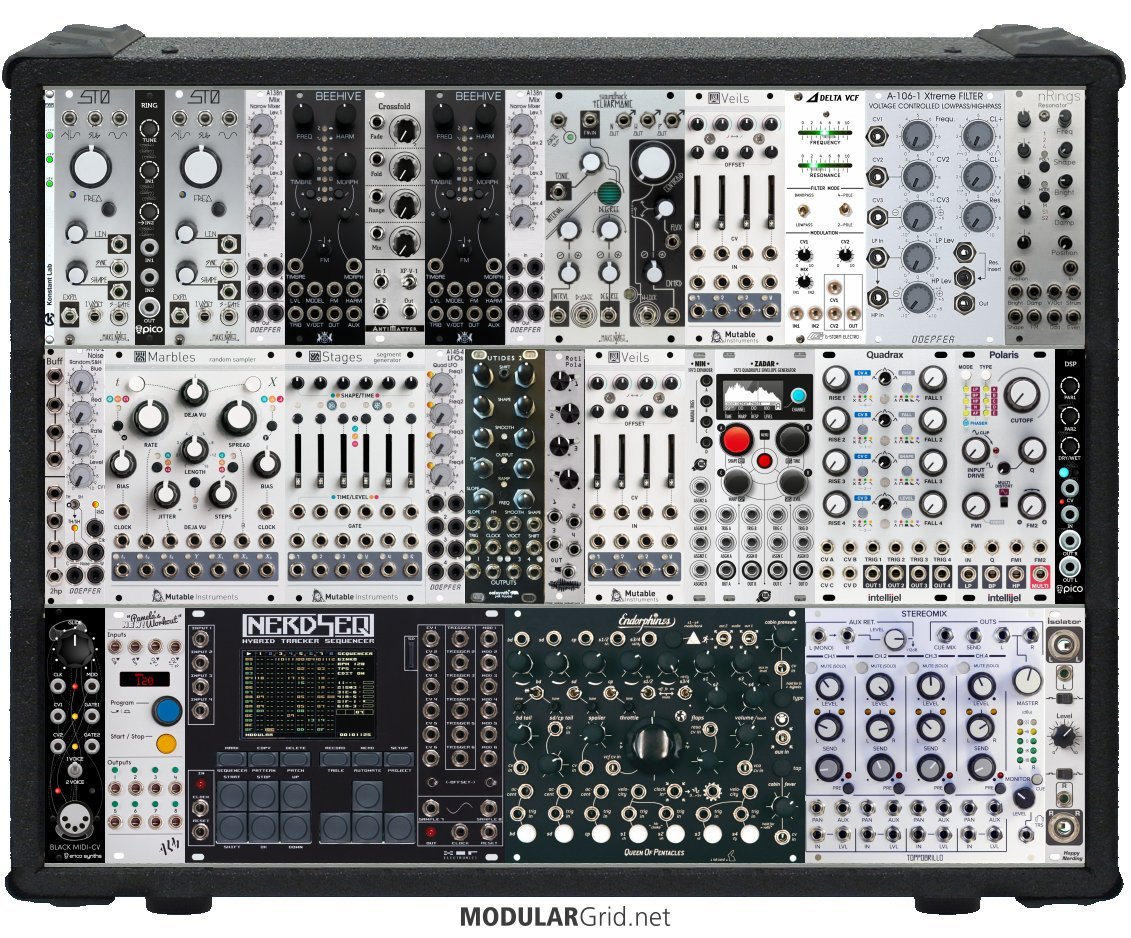Went nuts...because I'm GOING nuts in quarantine! AAAAAAAAAAAAAAAAAAAAAAAAAAAAA....
OK, now that that's out of my system, I beat on this for a hot minute before lunch, and wound up not only finding how to keep the Queen of Pentacles in the system, I wound up majorly expanding on the original build! Check this out:

Hot damn! OK...this actually does have much of the original in it! But what I did here was to jettison as many of the full sized Mutable modules when possible/practical, and this reclaimed a BIG chunk of space. So, when you got space, you do the logical thing...
First up, I shifted the entire layout so that audio is on top, modulation (and effects) is in the middle, sequencing and mixing and drums and such is now on the bottom, which should also get the umbilicals from the BSP to the endorphin drums out of the way of everything else. Audio row is left to right from sources to VCFs, with the final audio VCAs actually residing in the Toppobrillo Stereomix II at the bottom.
Top row: I added a Konstant Labs 1 hp power monitor (always useful!), then your STOs now have a Pico Ring (with its own sine VCO) between them, hinting that you might want to "unitize" this as an initial voice. It's also got its own submixer there. Next to this, I mashed the original Plaits into TWO Beehives, which ALSO have a very wild waveshaper/crossfolder for THEIR intermod thingamajig. And again, another submixer. In case you've not noticed, these two pairings with their mod circuits and mixers are now a bit more "West Coast-ish" in how they can interact. Telharmonium's in next, then the 10 hp NEW version of Veils provides VCA mixing of all subsections of tone generation before we get into the filtering. And for that, I changed things up a bit.
Filtering in this version is a lot more complex. First up is a very versatile G-Storm multimode VCF (and 2 to 1 submixer) that replicates the Korg Delta's. After that, I dropped in Doepfer's twisted version of the MS-20 Sallen-Key VCF pair. Why twisted? Well, because this thing's got an insert point in the resonance path...so instead of just having it filter things, you can run the filter's audio feedback through something else, such as the nanoRings next to it, a leg of the Polaris, etc. Oh, yeah...the Polaris is now down below this, alongside a Pico DSP which, actually, make a nice pairing since the Polaris has a mono out, and the DSP has a mono in and stereo out. This is important later...
Middle row: buffered mult, right above the MIDI interface. There are definitely enough "destinations" for CVs in this that it's prudent to add one. I got rid of the passive mult, also, because those are still a little bit much for this build size, and you should probably use inline mults or stackcables. Next, I added a noise/random source with an independent S&H/T&H, this all being there to work along with the Marbles. Stages is in next, since it works with clocking, together with the previous two modules as well as the sequencing below. I added four free-run LFOs after this, then the shrinky-dink version of the Tides. This has a Roti Pola next to both of these to allow mixing, attenuation, and polarization of mod signals. After this is another new Veils, the Zadar (which now has its expander), and then a Quadrax for AD, AR envelopes OR looping of these for up to four more LFOs if needed. Next to this are the effects, with one of these also posing as a "global" filter (the Polaris). These are just above the AUX send/return points on the Stereomix 2 for easy patching.
Annnnnnd...the bottom row: MIDI interface stayed the same, then I put in a New Pam's, which makes more sense here than the Tempi, since the Tempi is really at its best when used with the Rene mkii, while Pam's is better in a "mixed bag" timing situation such as this. NerdSEQ and the drums are next, then the Stereomix 2. Now, this thing is a BEAST...four mono inputs with CV over level, pan, and AUX send level, plus mute and cue sends. But the killer thing here is that you also get a mono AUX send and stereo return, allowing you to patch your effects (more than likely, the Pico DSP will stay parked here) and mix them properly. This also has a killer monitor section, with the cue function being great for live patch adjustments. And last, a balanced stereo pair with some nice transformers to add a little warmth if you push 'em a bit.
This SEEMS better. The layout makes far more sense, and should result in less of a snarl on the patch panel. The thing that's really wild, though, is that you now have three "voices" onboard alongside the drums. Pretty beefy, I think...but with a case this size, it really did teeter on the "could I keep that?" line, and I went for it instead of ejecting it. Results seem to have born my suspicions out this time!

